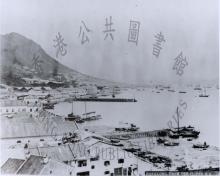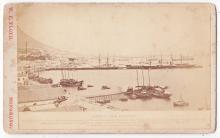Update Nov 2022: Changed completion date from 1872 to 1873, and added guessed demolition date of 1883 based on Moddsey's notes below.
The date is a guess, based on the year 1872 mentioned in this paragraph from Carl T Smith's "Wanchai: In Search of an Identity":
Marine Lots 29 and 30 were another speculative venture of George Duddell, who bought them at a government land sale in 1849. Augustus Carter, of Messrs Hegan & Co., had bought them at an earlier land sale in 1844, but he allowed them to revert to the government. Duddell sold them in 1854 to Hugh Hamilton Lindsay, of Messrs Lindsay & Co. who disposed of this property in 1861 to Gustav Overbeck and Edward Hutchinson Pollard. They in turn sold it in 1872 to the newly incorporated Hong Kong Pier and Godown Co. The Company overextended itself building godowns and a 1,000 feet wharf, equipiing it with steam cranes, engines, wagons and all the paraphernalia for moving cargo from ship to godown. As principal creditor, the Hong Kong and Shanghai Bank repossessed it in 1873. Four years later the bank found a buyer and conveyed it to Adolph Emil Meyer. In 1891 Messrs Mayer & Co. with other interested parties organised the Wanchai Wharehouse and Storage Co, Ltd. The Kowloon Wharf and Godown Co. leased the property in 1896.
And I'm not sure the exact date it was removed, but it isn't shown on the map in the 1885 Directory & Chronicle, so it was gone by then.
Better guesses welcome!



Comments
Timeline of the 1000 foot Pier at Wanchai
Timeline
1. 1872 - Authorization given to Hongkong Pier and Godown Company Ltd to construct a pier in the Harbour of Victoria. Government Gazette No. 25 issued on 15 June 1872 refers.
2. 1873 - An advertisement for the Company here The Hong Kong Daily Press 4 April 1873 (see here) notes the new pier and godowns, which have now been completed, under the direction of Messrs Wilson & Salway, architects and civil engineers, form a noticeable addition to the engineering works in Hong Kong. The Pier is 1000 feet long by 50 wide, and is built in the most solid manner of Manila hardwood, which has been carefully selected as most likely to resist the action of sea worms. There are two lines of rail running the length of the pier on each side, so that the trucks (wagons) can be kept passing the cargo up in constant rotation. A locomotive engine from Home is to draw them. A shed of corrugated iron, 250 feet long and 50 feet wide is to be erected to enable the cargo to be passed from one side to the other in wet weather.
The Company ceased operations on 1 August 1873 (Notice in Hong Kong Daily Press 3 September 1873) and later wound up and a liquidator appointed.
3. 1874 - The Pier survived the great typhoon of 1874. The Hong Kong Daily Press 24 September notes "the Pier had met the expectations of the builders by weathering a storm of greater magnitude than had expected. " However, the galvanised shed and other structures were blown away.
Noted an advertisement in the Hong Kong Daily Press on 24 September 1874 that the Hongkong and Wharf and Godowns Company (formerly the Hongkong Pier and Godowns Ltd) were open and ready for business from 23 September 1874. (The timing of this advertisement is right after the great typhoon).
Map - Plan of the City of Victoria showing the 1000 ft Pier is available at: https://alteagallery.com/view_product.php?prod_id=PROD100000850
4. 1876 - An article on frustration in the lack of suitable wharf accommodation in Hong Kong and growing sentiment for utilizing the "present useless Pier at Wanchai" for supplying this much felt want. China Mail 14 February 1876 refers. See here
5. 1878 - Meyer & Co advertised houses and godowns available for leasing on Marine Lot 65 and a dwelling house "Eastward of Pier at Wanchai." See here
Noted an advertisement in the Hong Kong Daily Press on 29 August 1878 that Meyer & Co were the propriet0rs of Hongkong Wharf and Godowns Company.
6. 1879 - A disastrous gale (typhoon ?) struck Hong Kong on 8 October. Mention is made of several sampans being hauled up on shore at Meyer's Wharf in Wanchai. Hong Kong Daily Press 9 October 1879 refers.
7. 1880 - Meyer & Co advertised a house on Marine Lot 65 and a house opposite the Wanchai Pier for leasing See here . A follow-up advertisement gives the location of the house as being opposite Wanchai Pier, Marine Lot 29. See here
8. 1881 - Meyer & Co. continues to advertise a house opposite the Wanchai Pier, Marine Lot 29 for leasing. China Mail 1 March 1881 refers.
9. 1882 - The Pier appears here on the Victoria Harbour Waterfront map.
10. 1884 - An article on the proposed construction of new piers and wharves in Hong Kong refers to the former Pier as the "Wanchai Pier" (probably named so for convenience due to its location). See Hong Kong Daily Press 22 May 1884 here It echoes comments made by the Harbour Master here that the failure of the previous enterprise was mainly due to the silting-up of the harbour at that part of Wanchai making the Pier inaccessible to large vessels.
11. 1885 - The Chronicle and Directory for China, Corea, Japan, the Philippines, Cochin China, Annam, Tonquin, Siam, Borneo, Straits Settlements, Malay States, etc. for the year 1885. Available online and see map of Wanchai here . As mentioned in the main text, the 1000 foot pier does not appear on the map.
Further Reading & Notes
1. Terminal Dilemma: Hong Kong’s Waterfront, 1841-1891 by Stephen Davies (see here ). Contemporary photographs show this Pier extending enormously – entailing the installation of Hong Kong’s first pier tramway – to cope with the siltation on which the Harbour Master comments. By the time it was demolished in the late 1870s/early 1880s, it was some 350m long.
2. Historical and Statistical Abstract of the Colony of Hong Kong 1841-1930. Available online here on Google Books
3. The Chronicle and Directory for China, Corea, Japan, the Philippines, Cochin China, Annam, Tonquin, Siam, Borneo, Straits Settlements, Malay States, etc. for the year 1879. Available online here . The set of district maps for Hong Kong is incomplete with the map for Wanchai missing.
4. Events in Hong Kong and the Far East 1875-1884. Published by the Hong Kong Daily Press in 1885. Available online here
5. China Families - Directories List of Companies etc available online here
Re: 1000 foot Pier
From what has been gleaned so far, the 1000 foot Wanchai Pier appears to have been completed in 1873. The Pier turned out to be a white elephant with its proprietors, the Pier & Godown Co. Ltd "collapsing" in the same year. Maps of Victoria Harbour show the Pier in situ in 1882 but had disappeared by 1885. Unfortunately, the missing years have not yielded sufficient clues to provide an accurate date of the Pier's demise.
Photos of the Pier
I have a few photos of the pier throughout its life
The first photo shows a much shorter pier, possibly while is was under construction:
This one is by William Pryor Floyd showing the newly constructed full pier
The third photo is of the offices & Godowns at the end of the pier
The last is of the pier in a ruined state. I have a few photos of the pier like this
My guess would be the pier was heavily damaged/destroyed in a typhoon/storm and the remains were subsequently left to rot in the harbour for a number of years. It doesn't look like the pier was being systemically demolished in the last photo.
Re:Recent Photos
Thanks for the recent photos. Went through typhoon related events from the pier’s construction to around 1885 but was not able to find a connection. For such a long pier, it is surprising there is not much information in the newspapers of the day of its removal or demise.
"100 foot pier"
The 1,000-foot pier possibly had a predecessor (the "100-foot pier") as shown here (you have to magnify the image):
update 2022-11-27
another photo from the 1870s here:
1883 Photo
Noted an 1883 photo here on eBay showing the pier intact.
THE NEW PIER
TO THE EDITOR OF THE DAILY PRESS
Sir,-Although the opposition to the erection of the New Pier has been conducted in the most desultory manner, still enough evidence has been produced to prove incontestably that it will be a great obstruction to traffic. The question consequently arises," Ought it or ought it not to be erected?” I do not know upon what grounds Parliamentary Committees in England reject private bills, but it appears to me to be the fair and reasonable course to approve of the bill, if the facilities to trade, which the pier will provide, cannot be obtained without this obstruction to traffic; and, on the other hand, to reject the bill, if equal facilities can be obtained without interfering with the traffic and other private interests.
It may be well to remind some of the members of Committee that energy and zeal go a great way in getting up a public company as well as in getting up a petition, and that what the public is really concerned about, is to get the best accommodation at the least inconvenience to itself. In other words, this is simply stating that the public, through its officials, is not necessarily bound to sanction the erection of a Pier, which, it is proved, will interfere with its convenience. The public can afford to await, and, if a Pier is so essentially necessary as it is represented to be, it is perfectly certain that a rival scheme will speedily make its appearance.
Any one walking along the Praya can see the enormous steamers of the P. M. S. Co.'s laying alongside a wharf which is so short that it can scarcely be said to interfere with cargo-boat traffic at all, and a little further along there is a bight beside the P. & O. Co.'s Coal Godowns, at which large steamers and ships may be seen lying within about 30 feet of the Prays Wall. Now, why is it that the Pier Company cannot utilise these natural advantages, and construct their piers along the shore, as all the wharves at Singapore are constructed, and as all those at Shanghai are also constructed? Why is it that they want to run a pier 1,000 feet out into the sea, and obstruct traffic?
I need say nothing as to the evident bias of the Chairman of Committee, and the best commentary that can be given to his assertion of the public demand for the pier, is the quotation of its Shares already at 12 per cent discount.
I am, yours faithfully, D. W.
Hongkong, 7th Nov., 1871.
Hong Kong Daily Press, 1871-11-08
Personal note: Being against something new seems not to be a recent phenomenon.